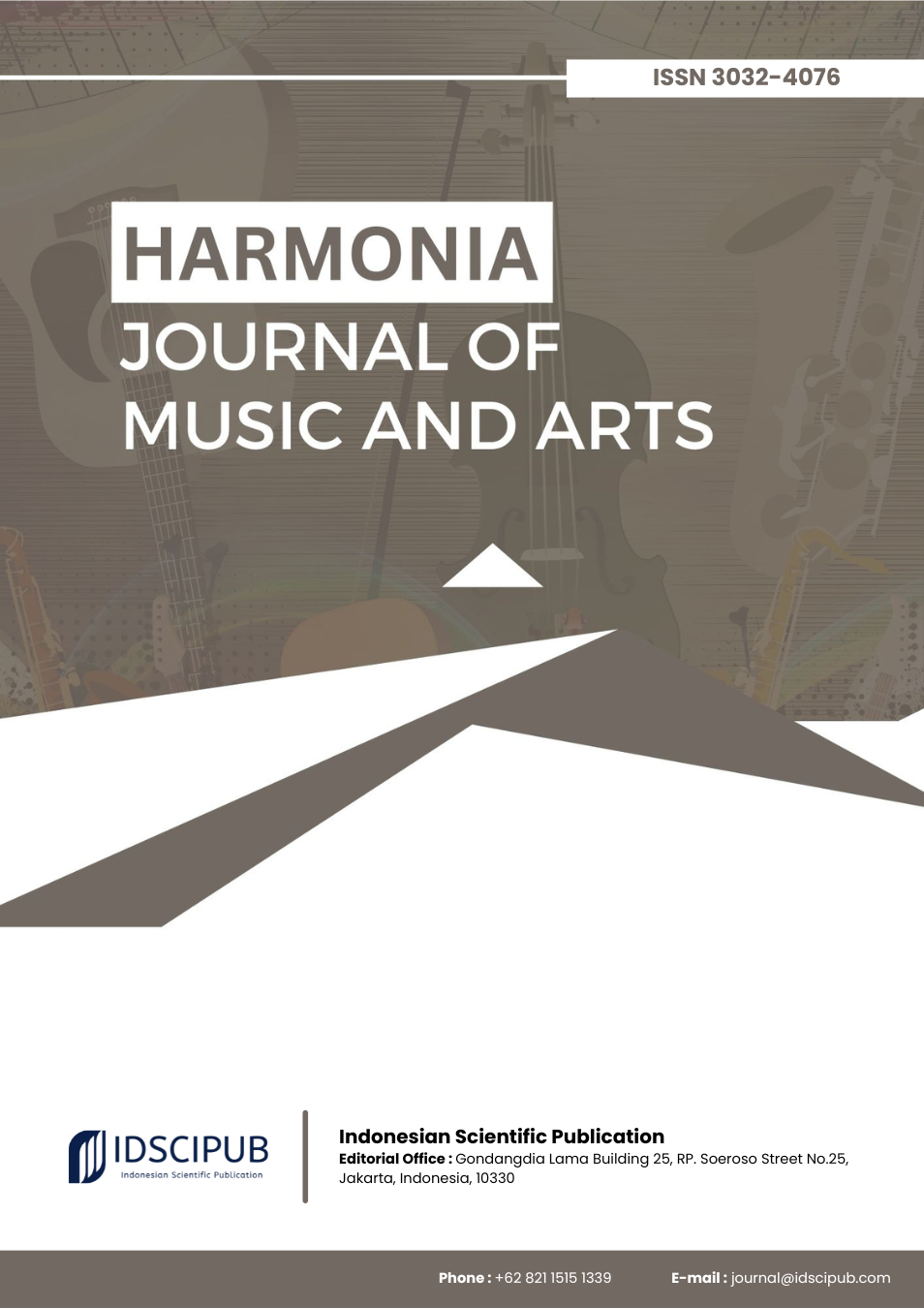Rethinking Arts Education in the Digital Era: A Narrative Review
DOI:
https://doi.org/10.61978/harmonia.v3i2.898Keywords:
Digital Transformation, Arts Education, Pedagogy, Curriculum Innovation, Artificial Intelligence, Augmented Reality, Global PerspectivesAbstract
This study provides a narrative review of digital transformation in arts education, with a focus on pedagogical models, curriculum innovation, technological integration, and global perspectives. The review draws on literature from databases including Scopus, Web of Science, Google Scholar, and PubMed, using keyword combinations related to digital transformation, pedagogy, and arts education. Inclusion criteria emphasized peer-reviewed studies published between 2015 and 2025, spanning diverse research designs. The findings indicate that project-based and STEAM learning approaches, combined with digital tools such as artificial intelligence and augmented reality, significantly improve student engagement, creativity, and adaptability. Curriculum reforms incorporating e-learning, blended, mobile, and ubiquitous learning models demonstrate how institutions globally are redesigning education to meet digital challenges. At the same time, systemic barriers—including insufficient infrastructure, limited teacher training, and policy gaps—continue to hinder effective implementation, particularly in developing countries. Comparative analyses highlight stark disparities between developed and developing contexts but also reveal innovative practices emerging from resource-constrained environments. The discussion emphasizes the importance of inclusive policies, sustained professional development, and international collaboration in addressing these barriers. Future research is needed to provide longitudinal evidence of the long-term impact of digital integration on creativity and professional readiness. The review concludes that digital technologies, when strategically integrated, are not supplementary but foundational to the future of arts education.
References
Almogren, A. (2022). Art education lecturers’ intention to continue using the blackboard during and after the COVID-19 pandemic: An empirical investigation into the UTAUT and TAM model. Frontiers in Psychology, 13, 944335. https://doi.org/10.3389/fpsyg.2022.944335 DOI: https://doi.org/10.3389/fpsyg.2022.944335
Alnasib, B. (2022). Digital competencies: Are pre-service teachers qualified for digital education? International Journal of Education in Mathematics Science and Technology, 11(1), 96–114. https://doi.org/10.46328/ijemst.2842 DOI: https://doi.org/10.46328/ijemst.2842
Asad, M., & Malik, A. (2023). Cybergogy paradigms for technology-infused learning in higher education 4.0: A critical analysis from global perspective. Education + Training, 65(6/7), 871–890. https://doi.org/10.1108/et-08-2022-0324 DOI: https://doi.org/10.1108/ET-08-2022-0324
Astuti, W., Nurkamto, J., Subiyantoro, S., & Rochsantiningsih, D. (2024). Exploring the potential development of digital modules for arts and culture learning based on local culture: A mixed-method study on bedhaya ketawang dance. Edelweiss Applied Science and Technology, 8(5), 2327–2342. https://doi.org/10.55214/25768484.v8i5.1986 DOI: https://doi.org/10.55214/25768484.v8i5.1986
Boiko, O., Bondar, M., Boiko, L., Byrkovych, T., Furdychko, A., & Hurbanska, S. (2023). The digital age of higher art education (European experience): Professional competence, development, innovation. Journal of Higher Education Theory and Practice, 23(13). https://doi.org/10.33423/jhetp.v23i13.6320 DOI: https://doi.org/10.33423/jhetp.v23i13.6320
Cacciuttolo, C., Guzmán, V., Catriñir, P., Atencio, E., Komarizadehasl, S., & Galant, J. (2023). Low-cost sensors technologies for monitoring sustainability and safety issues in mining activities: Advances, gaps, and future directions in the digitalization for smart mining. Sensors, 23(15), 6846. https://doi.org/10.3390/s23156846 DOI: https://doi.org/10.3390/s23156846
Gomes-Ribeiro, P., & Malhado, A. (2024). The shadow side of musical composition: A study of library music in Portuguese academic circles. Music Sound and the Moving Image, 18(2), 177–202. https://doi.org/10.3828/msmi.2024.12 DOI: https://doi.org/10.3828/msmi.2024.12
Hamal, O., Faddouli, N., Harouni, M., & Lu, J. (2022). Artificial intelligent in education. Sustainability, 14(5), 2862. https://doi.org/10.3390/su14052862 DOI: https://doi.org/10.3390/su14052862
Hua, T. (2021). Optimization of hybrid multimedia art and design teaching mode in the era of big data. Scientific Programming, 2021, 1–11. https://doi.org/10.1155/2021/8266436 DOI: https://doi.org/10.1155/2021/8266436
Kortjass, M., & Mkhize-Mthembu, N. (2023). Reflecting on teaching in the higher education context during the COVID-19 era: A collaborative self-study project. Educational Research for Social Change, 12(2), 44–61. https://doi.org/10.17159/2221-4070/2023/v12i2a4 DOI: https://doi.org/10.17159/2221-4070/2023/v12i2a4
Leavy, A., Dick, L., Meletiou-Mavrotheris, M., Paparistodemou, E., & Stylianou, E. (2023). The prevalence and use of emerging technologies in STEAM education: A systematic review of the literature. Journal of Computer Assisted Learning, 39(4), 1061–1082. https://doi.org/10.1111/jcal.12806 DOI: https://doi.org/10.1111/jcal.12806
Li, J. (2023). Research on the development of digitalization of art education in the era of big data technology. Applied Mathematics and Nonlinear Sciences, 9(1). https://doi.org/10.2478/amns.2023.2.00568 DOI: https://doi.org/10.2478/amns.2023.2.00568
Liou, J., Ziegler, M., & Schwierz, F. (2024). Gigahertz and terahertz transistors for 5G, 6G, and beyond mobile communication systems. Applied Physics Reviews, 11(3). https://doi.org/10.1063/5.0213011 DOI: https://doi.org/10.1063/5.0213011
Meilinda, M., Wibawa, S., & Irawan, S. (2024). Indonesian performing arts in the era of COVID-19: Digitizing campus theatre. Asiascape Digital Asia, 11(1–2), 85–101. https://doi.org/10.1163/22142312-bja10057 DOI: https://doi.org/10.1163/22142312-bja10057
Mossalim, J. (2024). AI and AR in the elementary school art class. In Handbook of digital pedagogy in education (pp. 125–152). https://doi.org/10.4018/979-8-3693-3184-2.ch005 DOI: https://doi.org/10.4018/979-8-3693-3184-2.ch005
Qiu, J. (2024). A philosophical inquiry into practical music education in the digital age. Applied Mathematics and Nonlinear Sciences, 9(1). https://doi.org/10.2478/amns-2024-0065 DOI: https://doi.org/10.2478/amns-2024-0065
Rangel, P., & Díaz, M. (2023). Enfoque STEAM en la educación superior colombiana frente a la cuarta revolución. Educación Y Humanismo, 25(45). https://doi.org/10.17081/eduhum.25.45.6152 DOI: https://doi.org/10.17081/eduhum.25.45.6152
Rodríguez, M., Lígorred, V., Carrasco, Á., & Vallecillo, N. (2022). Ecosistema de la educación artística en red: Una revisión de los antecedentes, las posibilidades y las perspectivas en la era digital. Revista Complutense de Educación, 33(4), 679–690. https://doi.org/10.5209/rced.76499 DOI: https://doi.org/10.5209/rced.76499
Sousa, C., Rye, S., Sousa, M., Torres, P., Perim, C., Mansuklal, S., … & Ennami, F. (2023). Playing at the school table: Systematic literature review of board, tabletop, and other analog game-based learning approaches. Frontiers in Psychology, 14, 1160591. https://doi.org/10.3389/fpsyg.2023.1160591 DOI: https://doi.org/10.3389/fpsyg.2023.1160591
Tao, Y., & Tao, Y. (2024). Integrating aesthetic education in quality education: A bibliometric analysis of sustainable development perspectives. Sustainability, 16(2), 855. https://doi.org/10.3390/su16020855 DOI: https://doi.org/10.3390/su16020855
Wei, C. (2024). A practical approach to the reform of “three teachings” in the age of digitalization to promote the high-quality development of higher vocational education. Applied Mathematics and Nonlinear Sciences, 9(1). https://doi.org/10.2478/amns-2024-0164 DOI: https://doi.org/10.2478/amns-2024-0164
Xiao, H. (2022). Innovation of digital multimedia VR technology in music education curriculum in colleges and universities. Scientific Programming, 2022, 1–9. https://doi.org/10.1155/2022/6566144 DOI: https://doi.org/10.1155/2022/6566144
Xiao, L., & Yan, L. (2024). Multimedia delivery and teaching innovation of civic value in art education in the digital media era. Applied Mathematics and Nonlinear Sciences, 9(1). https://doi.org/10.2478/amns-2024-2995 DOI: https://doi.org/10.2478/amns-2024-2995
Zailuddin, M., Harun, N., Rahim, H., Kamaruzaman, A., Berahim, M., Harun, M., … & Ibrahim, Y. (2024). Redefining creative education: A case study analysis of AI in design courses. Journal of Research in Innovative Teaching & Learning, 17(2), 282–296. https://doi.org/10.1108/jrit-01-2024-0019 DOI: https://doi.org/10.1108/JRIT-01-2024-0019






